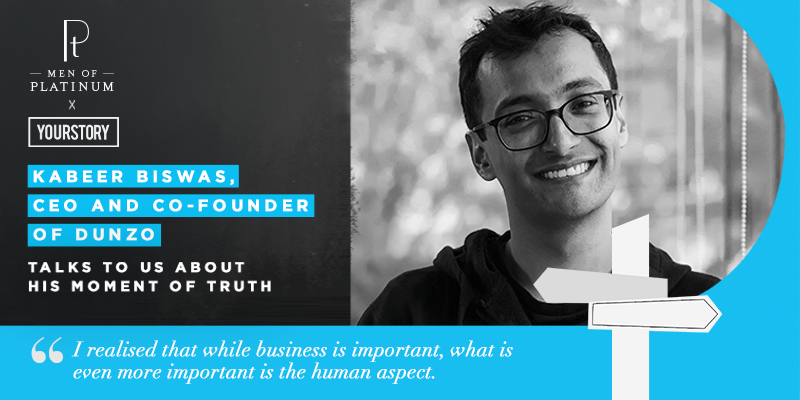India is more relevant to Cisco than ever before: Rob Salvagno, Head of Corporate Development, Cisco
Tech giant Cisco, which has invested in 20 startups in India, plans to work closely with the entrepreneurial ecosystem, track innovation, and invest more in the country going forward.
Multibillion-dollar technology giant Cisco has been pushing boundaries in software with several acquisitions. Of the 24 acquisitions made globally over the last two years, around 20 have software as the core business.
Rob Salvagno, who has spent 18 years in Cisco, leads the Corporate Development team and is responsible for driving Cisco’s M&A and Corporate Venture Capital activity. Rob has executed dozens of acquisitions and investments, constructed major spin-ins such as Nuova and Insieme, and helped launch new innovation projects within Cisco.
In an interview with YourStory, Rob says India has finally achieved maturity to build B2B businesses that could go global and that commitment to India, through its fund, is going to increase. The company has made investments in more than 120 companies globally and Cisco’s plans in India are to work closely with the entrepreneurial ecosystem. Edited excerpts of the interview.

YourStory: Tell us about Cisco’s M&A activity and how it fits into the Indian context.
Rob Salvagno: Let me start by providing my point of view. I lead the corporate development team for the last two and half years; this also coincides with when Chuck stepped in as the CEO of Cisco. From a broader perspective of what I have seen is that the pace of change happening in the world today, led by technology, is unprecedented. What that has led to, for companies and customers, is that you have to figure out how to innovate faster. At Cisco, we have a five-pillar approach on how we think about innovation.
- Build – internal R&D
- Buy essentially M&A
- Partner – partnering with companies like Apple and Ericsson
- Co-develop – working with our customers to build new solutions
- Invest
This five-pillar approach has put us in a unique position over the years to navigate the transitions we’re seeing in the market place.
YS: There have been lots of changes over the last seven years in terms of technologies?
RS: Yes. As the lead for corporate development, I have responsibility for two of those five pillars - the investment side and the acquisition side. That has been a great lens in terms of how we’ve really gone about this transformation as a company. Investments have provided us with that forward-looking lens. We can look ahead three, five or 10 years in terms of the technologies and the business models that may impact Cisco and our customers on a global basis.
We see many opportunities and think that the fastest way to get there is, really, to go outside the company – that’s where M&A comes in. To put it in perspective, we’ve done north of 200 acquisitions as a company. So it’s fundamentally part of our culture. On the investment side, we are a very active strategic investor. We have an active portfolio of over 120 companies, and investments in over 40 funds.
India is a top priority for us as a region. It has been top priority for us from a development perspective where we have over 10,000 people here. I also see it as a top priority from an innovation perspective. We are starting to see pockets of broader enterprise and B2B innovation. India is more relevant to Cisco than ever before. What that means, from my point of view, is that you know we want to put ourselves in the best position to keep our tabs on innovations. I expect our investment activity to increase both directly in the companies as well as deepening our relationship with the venture ecosystem.
A few months ago, we announced an investment in Stellaris, which is, in our view, one of the leading India VCs really focused around B2B and enterprise technologies. We have also made a second commitment to another India-based VC. All this adds up to Cisco going through this large transformation as a company, from hardware and a perpetual sales company to one that is software and recurring revenue-based. Investments in M&A have played a huge part, allowing us to have a lens in terms of where the world is going, and the ability to bring in some of those capabilities through M&A. As it relates to India, I see India as just increasing as a priority relative to that effort.
YS: You want to start off the transition from hardware sales to software? You took over this portfolio two-and-half years ago. Was that when the genesis for a global outlook began?
RS: I think that there has been a focus on transformation for longer than the last two and half years. I think Chuck has really brought a level of focus; prioritisation of that has accelerated the journey. As it relates to my particular role, M&A has also played a big part in that transformation. Over that same two-and-half-year period, we have acquired approximately 24 companies. I would say that probably almost 20 out of those 24 companies were software-based. The large majority of revenue of those companies is from high margin software, but also recurring in nature. Our M&A strategy has also followed the transformation that Chuck charted for us, and helped in that acceleration.
There are probably a few themes that you could look at our M&A strategy contributing to. One approach towards M&A follows the top priorities that we have as a company, which is software. Those areas are evolving our networking business looking at data and analytics, looking at the user experience from an IoT and collaboration perspective, observing a transition towards cloud, and finally surrounding everything by security. Our M&A strategy has closely chartered those areas. We have made large acquisitions.
Firstly, on the analytics side, we made a large acquisition a little over a year ago with AppDynamics. This acquisition has really established a new market for us in application monitoring. Secondly, we’ve used M&A to capture some of these transitions happening as a result of cloud. Viptela is an example of the transition towards cloud within the edge or SDN – routing businesses. We have also used M&A to bring emerging technologies into Cisco.
You also mentioned AI; we acquired our first AI company, MindMeld, about a year and half ago. That brings natural language processing into our collaboration business. Everybody is familiar with things like Siri from a consumer point of view. We want to bring some of those notions into enterprise tech. So, those are some good examples of how M&A has followed our strategy and some of the key themes I would highlight as part of that.
YS: How difficult was it to convince stakeholders that this was the way forward? People talk AI, machine learning, and other things, but how do you know it’s the right way forward?
Rob: Any company has to ask itself what are the tools that I need to make that transformation. I think one of the things that makes Cisco unique is that we can bring five different capabilities to bear. Maybe sometimes it’s right to look at internal development to make that transformation. You’ve seen that recently with the Catalyst 9,000, the fastest growing product Cisco has ever made. In certain areas we may need to partner, where there is capability that our customers desire that perhaps isn’t appropriate to own. Our partnership with Apple is a great example of that; we do think of them as a very relevant partner. By bringing Cisco and Apple together - from a collaboration and security perspective - we can add a lot of value.
M&A really comes into play where we think there’s a need to bring in outside capabilities. Transformation is tough; I think that one of the keys is how you can execute towards it. I think that is something that Cisco has done very well because of the different tools we have available to us.
YS: What kind of presentations or pitches do you look for from entrepreneurs?
RS: We look for sustainable technology, for companies that we believe can take a number one or two position in the marketplace over time. We look for opportunities that can be billion-dollar-plus markets. We also look for a shared vision and culture with the people on the team we are looking to bring over. All of those are ingredients or inputs into how we think about attractive acquisition targets.
YS: Why India now? Do you see interest in startups with tech really growing? Or do you see hardcore product companies?
RS: I think you see an accumulation of factors that is making Cisco much more optimistic about the level of enterprise in B2B innovation possible here. One, you have a set of country initiatives focused on things like digital health, education, and smart cities, which we think has an ability to spur innovation. Two, you have some very significant developments like India Stack or Aadhaar that are providing a foundation for things like payments and fintech that is unprecedented in terms of what I’ve seen in other regions before. Three, you have an evolving venture and entrepreneurial ecosystem, where you have entrepreneurs and a maturing venture ecosystem to support them. I think all that is going to lead to more opportunity.
Our goal is to make sure that we can track that innovation and I expect Cisco to invest more in India going forward than we have in the past. It already was a top priority for Cisco. We have made investments in more than 20 Indian startups over our history. I expect the pace of our investments to go up going forward, given some of these factors. We invest off the balance sheet today. We are essentially looking for the most innovative opportunities. I have a global team of 50 people, with a third of that team outside of the US. We really have an ability to focus those investment dollars in areas we think are the most promising. But what does promising mean? Promising means one, do we think it could be strategic over time to Cisco or customers? Two, do we think they are going to be a successful company? Where we see those opportunities to create that type of value, that’s where we’ll make our investments.
YS: You’ve worked closely in China? Tell us about that.
RS: China is also a big priority for Cisco. It is another area where I have team members and where we’ve invested directly through funds and done things like joint ventures. It is a market that we’ve participated in full time.
YS: How different are the markets? If you were to look at Europe, the US, Latin America, and China, how do you prioritise each market? At what stage of entrepreneurship are these countries and how different is India?
RS: It’s a good question. I would say that some of the same things that make us optimistic about India also make us optimistic about China. Both represent very large markets. Both are areas Cisco has made significant R&D investments in. We have significant resources from an engineering perspective. Both of them exhibit really healthy startup and venture ecosystems, which speak to the fact that a lot of innovation is happening in those marketplaces. So, every region is slightly different, but those are three positive aspects that I think make both these markets large and also ones that I think are going to be a source of innovation for many years to come.
My biggest takeaway from what you just referred to, about India being different, is the importance of having a global investment perspective. This means the Indian market has emerged differently than a market like the US. That doesn’t make it good or bad. It makes it different. The differences within what can be a really large market can lead to completely new opportunities we haven’t actually seen elsewhere.
So, in India, you have more of a “mobile-first” type of environment. Well, if you’re thinking about things like SaaS, you have to approach that differently than maybe a company had to in the US. That difference just leads to the fact that there could be opportunities in companies created in India that actually are unique given those attributes. If you didn’t focus on India, you actually may miss something born as a result of the unique market here. We think that is critical to pay attention to.
YS: Do you think Boston and the Bay area were successful because of a long-term view on investing in startups? Do we need that kind of a vision?
RS: I believe what has made Silicon Valley so successful is the ecosystem. So, the question I have when I look at a region like India is “what is the opportunity for an ecosystem to exist”? That’s one of the elements that makes me very bullish about the region and also something I think Cisco can contribute to. Let’s first talk about what makes us bullish. One: a significant educational foundation driving a huge pipeline of talent into this market, which is great. Two: a maturing venture ecosystem looking to invest over the long term. Three: you have global companies that are participating here. Innovations that can be made here have the potential to impact a much broader market outside of India as well.
At Cisco, we believe we can help drive bring an ecosystem approach to how we think about this innovation. We have talked a lot about our investment pieces. Then we have things like LaunchPad, essentially a touch point we have with the entrepreneurial community. That’s really driven by the engineering team here. We are creating multiple touch points to create a healthier environment for entrepreneurs and people looking to build new companies within India.
YS: You went to Stanford. Does education play a valuable role in building entrepreneurship as a mindset? The Bay Area churns out entrepreneurs more than MBAs, right?
RS: If I had to point out two things, I would say education and attitude. Let’s look at India through those two pillars. On the education side, I think it’s unquestionable that some of the best technology institutions in the world are here. What is changing is the attitude and mindset of graduates; I think they are much more likely to opt for a startup than they were five or 10 years ago. The mentality is changing and I think the talent that is coming out is – attitude-wise - more entrepreneurial. That combined with the educational foundation creates a tremendous opportunity.











![[App Friday] NiyoX has the right idea of what millennials want from banks today, but its execution is glitchy and needs fixing](https://images.yourstory.com/cs/2/f49f80307d7911eaa66f3b309d9a28f5/AppFriday-17-1646923183039.png)